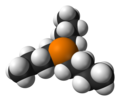Tributylphosphine

| |
 | |
| Names | |
|---|---|
| Preferred IUPAC name
Tributylphosphane | |
| Other names
Tributylphosphine
| |
| Identifiers | |
3D model (JSmol)
|
|
| ChEMBL | |
| ChemSpider | |
| ECHA InfoCard | 100.012.410 |
| EC Number |
|
PubChem CID
|
|
| UNII | |
| UN number | 3254 |
CompTox Dashboard (EPA)
|
|
| |
| |
| Properties | |
| P(CH2CH2CH2CH3)3 | |
| Molar mass | 202.322 g·mol−1 |
| Appearance | Colorless oily liquid |
| Odor | Stench, nauseating |
| Density | 0.82 g/ml |
| Melting point | −60 °C; −76 °F; 213 K |
| Boiling point | 240 °C; 464 °F; 513 K (150 °C (302 °F; 423 K) at 50 mmHg) |
| negligible | |
| Solubility | organic solvents such as heptane |
| Related compounds | |
Related
|
|
| Hazards | |
| Occupational safety and health (OHS/OSH): | |
Main hazards
|
Stench, Flammable, Corrosive |
| GHS labelling: | |
   
| |
| Danger | |
| H226, H250, H251, H302, H312, H314, H411 | |
| P210, P222, P233, P235+P410, P240, P241, P242, P243, P260, P264, P270, P273, P280, P301+P312, P301+P330+P331, P302+P334, P302+P352, P303+P361+P353, P304+P340, P305+P351+P338, P310, P312, P321, P322, P330, P363, P370+P378, P391, P403+P235, P405, P407, P413, P420, P422, P501 | |
| NFPA 704 (fire diamond) | |
| Flash point | 117 °C (243 °F; 390 K) |
| 168 °C (334 °F; 441 K) | |
| Lethal dose or concentration (LD, LC): | |
LD50 (median dose)
|
750 mg/kg (oral, rats) |
Except where otherwise noted, data are given for materials in their standard state (at 25 °C [77 °F], 100 kPa).
| |
Tributylphosphine is the organophosphorus compound with the chemical formula P(CH2CH2CH2CH3)3, often abbreviated as PBu3. It is a tertiary phosphine. It is an oily liquid at room temperature, with a nauseating odor. It reacts slowly with atmospheric oxygen, and rapidly with other oxidizing agents, to give tributylphosphine oxide. It is usually handled using air-free techniques.
Preparation
[edit]Tributylphosphine is prepared industrially by the hydrophosphination of phosphine with 1-butene: the addition proceeds by a free radical mechanism, and so the Markovnikov rule is not followed.[1]
- PH3 + 3 CH2=CHCH2CH3 → P(CH2CH2CH2CH3)3
Tributylphosphine can be prepared in the laboratory by reaction of the appropriate Grignard reagent with phosphorus trichloride although, as it is commercially available at reasonable prices, it is rare to have to perform the small-scale preparation.
- 3 CH3CH2CH2CH2MgCl + PCl3 → P(CH2CH2CH2CH3)3 + 3 MgCl2
Reactions
[edit]Tributylphosphine reacts with oxygen to give the corresponding phosphine oxide (here tributylphosphine oxide):
- 2 P(CH2CH2CH2CH3)3 + O2 → 2 O=P(CH2CH2CH2CH3)3
Because this reaction is so fast, the compound is usually handled under an inert atmosphere.
The phosphine is also easily alkylated. For example, benzyl chloride gives a phosphonium salt (here tributyl(phenylmethyl)phosphonium chloride):[2]
- P(CH2CH2CH2CH3)3 + PhCH2Cl → [PhCH2P(CH2CH2CH2CH3)3]+Cl−
Tributylphosphine is a common ligand for the preparation of complexes of transition metals in low oxidation states. It is cheaper and less air-sensitive than trimethylphosphine and other trialkylphosphines. Although its complexes are generally highly soluble, they are often more difficult to crystallize compared to complexes of more rigid phosphines. Furthermore, the 1H NMR properties are less easily interpreted and can mask signals for other ligands. Compared to other tertiary phosphines, it is compact (cone angle: 136°) and basic (χ-parameter: 5.25 cm−1)[3]
Use
[edit]Tributylphosphine finds some industrial use as a catalyst modifier in the cobalt-catalyzed hydroformylation of alkenes, where it greatly increases the ratio of straight-chain aldehydes to branched-chain aldehydes in the product mixture.[4] However, tricyclohexylphosphine is even more effective for this purpose (although more expensive) and, in any case, rhodium catalysts are usually preferred to cobalt catalysts for the hydroformylation of alkenes.
It is the precursor to the pesticide (2,4-dichlorobenzyl)tributylphosphonium chloride ("Phosfleur").[2]
Although tributylphosphine is generally regarded as toxic, its biological effects can be manipulated by drug delivery strategies. For example, a photoactivatable version of tributylphosphine has been used to induce disulfide bond cleavage and reductive stress in living cells.[5]
Odor
[edit]The main laboratory inconvenience of tributylphosphine is its unpleasant smell.
Hazards
[edit]Tributylphosphine is moderately toxic, with an LD50 of 750 mg/kg (oral, rats).[2]
References
[edit]- ^ Trofimov, Boris A.; Arbuzova, Svetlana N.; Gusarova, Nina K. (1999). "Phosphine in the synthesis of organophosphorus compounds". Russian Chemical Reviews. 68 (3): 215–227. Bibcode:1999RuCRv..68..215T. doi:10.1070/RC1999v068n03ABEH000464. S2CID 250775640.
- ^ a b c Jürgen Svara, Norbert Weferling and Thomas Hofmann "Phosphorus Compounds, Organic" in Ullmann's Encyclopedia of Industrial Chemistry, 2006, Wiley-VCH, Weinheim. doi:10.1002/14356007.a19_545.pub2
- ^ Rahman, M. M.; Liu, H. Y.; Prock, A.; Giering, W. P. (1987). "Steric and Electronic Factors influencing Transition-Metal–Phosphorus(III) Bonding". Organometallics. 6 (3): 650–58. doi:10.1021/om00146a037.
- ^ Bell, P.; Rupilus, W.; Asinger, F. (1968). "Zur Frage der Isomerenbildung bei der Hydroformylierung Höhermolekularer Olefine mit Komplexen Kobalt- und Rhodiumkatalysatoren". Tetrahedron Lett. 9 (29): 3261–66. doi:10.1016/S0040-4039(00)89542-8.
- ^ Tirla, A.; Rivera-Fuentes, P. (2016). "Development of a Photoactivatable Phosphine Probe for Induction of Intracellular Reductive Stress with Single-Cell Precision". Angew. Chem. Int. Ed. 55 (47): 14709–14712. doi:10.1002/anie.201608779. hdl:20.500.11850/123593. PMID 27763731.

